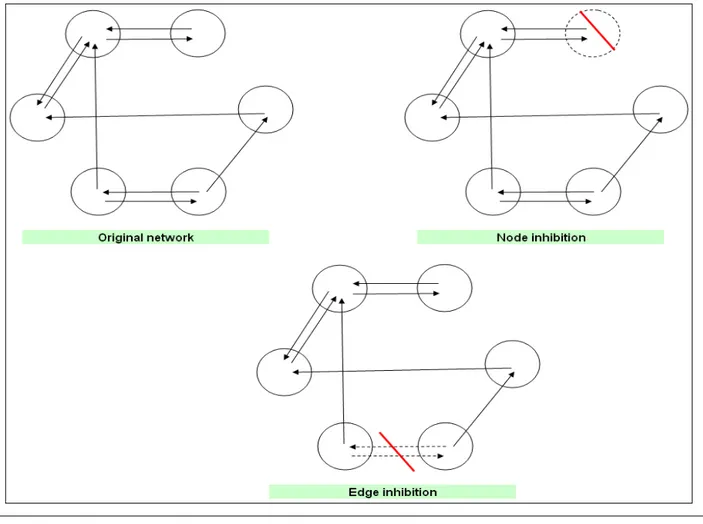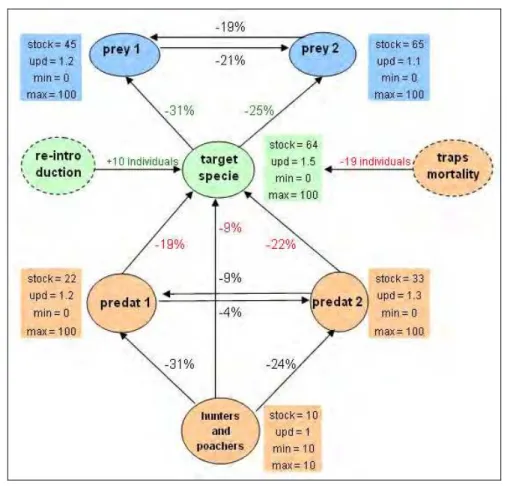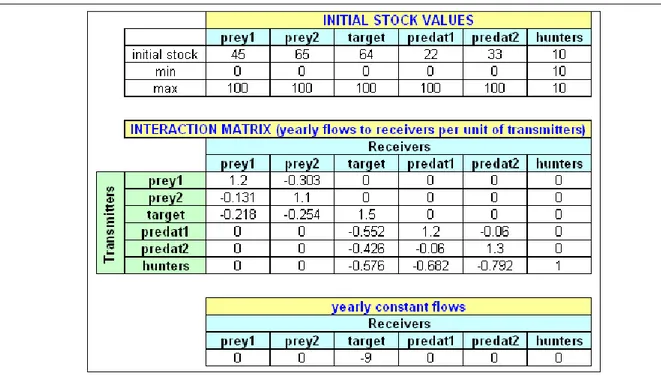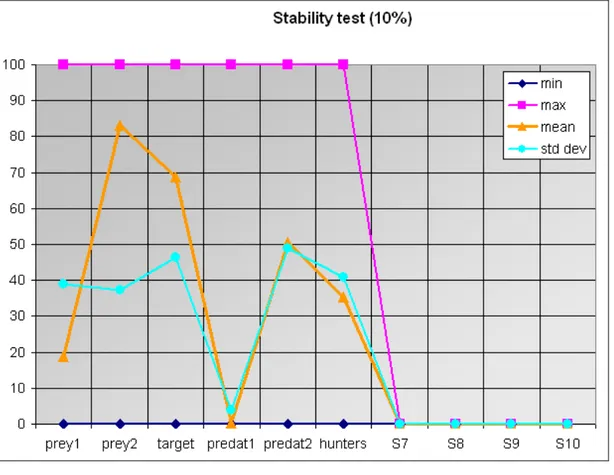IAEES www.iaees.org
Article
Structural control of ecological and biological networks
Alessandro Ferrarini
Department of Evolutionary and Functional Biology, University of Parma, Via G. Saragat 4, I-43100 Parma, Italy E-mail: sgtpm@libero.it, alessandro.ferrarini@unipr.it, a.ferrarini1972@libero.it
Received 26 July 2016; Accepted 5 September 2016; Published 1 December 2016
Abstract
Evolutionary Network Control (ENC) allows the control of any kind of ecological and biological network, with an arbitrary number of nodes and links. In this work, ENC has been further expanded to incorporate the
structural control of any kind of ecological and biological network. The rationale behind Structural ENC is that during field experiments and manipulations it could result difficult to quantitatively control stocks and flows in order to drive the ecological or biological network towards the desired state. In these cases, similar results can be achieved using a more parsimonious approach based on the inhibition of one or several nodes and/or edges. Although network control through the inhibition of one or several nodes and/or edges is a kind of structural control that acts impolitely if compared to the functional control previously used by ENC, it is more parsimonious from a feasibility (i.e. in situ application) viewpoint, hence in some cases it could be the most feasible solution for the control of the real networks.
Keywords dynamical networks; genetic algorithms; Evolutionary Network Control; edge inhibition; node inhibition; network control; system dynamics.
1 Introduction
Evolutionary Network Control (ENC) has been introduced to allow the control of any kind of ecological and biological network, with an arbitrary number of nodes and links (Ferrarini, 2013; Ferrarini, 2013b). ENC can be applied to both discrete-time (i.e., systems of difference equations) and continuous-time (i.e., systems of differential equations) networks. ENC opposes the idea, very common in the scientific literature, that controllability of networks should be based on the identification of a subset of nodes to be permanently controlled (Ferrarini, 2011).
ENC uses an integrated solution (system dynamics - genetic optimization - stochastic simulations) to compute uncertainty about network control (Ferrarini, 2013c) and to compute control success and feasibility
Computational Ecology and Software ISSN 2220721X
URL: http://www.iaees.org/publications/journals/ces/onlineversion.asp RSS: http://www.iaees.org/publications/journals/ces/rss.xml
Email: ces@iaees.org EditorinChief: WenJun Zhang
IAEES www.iaees.org (Ferrarini, 2013d). ENC employs intermediate control functions to locally (step-by-step) drive ecological and biological networks (Ferrarini, 2014). ENC can globally subdue nonlinear networks (Ferrarini, 2015), impose early or late stability to any kind of ecological and biological network (Ferrarini, 2015b) and locally control nonlinear networks (Ferrarini, 2016). A decentralized network control has already been conceptualized that is particularly suitable for big data networks (Ferrarini, 2016b). A multi-purpose variant of ENC (Ferrarini, 2016c) has been developed to simultaneously control an arbitrary number of network dynamics.
In this work, ENC has been further expanded to incorporate the structural control of any kind of ecological and biological network. The rationale behind Structural ENC is that sometimes it could result rather difficult to quantitatively control stocks and flows in order to drive the ecological or biological network towards the desired state (Fig. 1). In these cases, similar results can be achieved using a more parsimonious approach based on the inhibition of one or several nodes and edges.
Although network control through the inhibition of one or several nodes and/or edges could seem a raw approach if compared to the previously-described functional control, it is more parsimonious from a feasibility (i.e. in situ application) viewpoint, hence in some cases it could be the most feasible solution for the control of the real networks.
IAEES www.iaees.org 2 Structural Evolutionary Network Control: Mathematical Formulation
An ecological (or biological) dynamical system of n interacting taxonomic resolutions (species, genera, family, etc.) or aggregated assemblages of taxa (e.g., phytoplankton) is as follows
(1)
where Si is the number of individuals (or the total biomass) of the generic i-th taxonomic resolution (species, genera, family, or aggregated assemblages of taxa) with inputs (e.g. species reintroductions) and outputs (e.g. hunting) from outside. Most real systems’ dynamics can be modelled and simulated using a system of canonical linear equations (Luenberger, 1979; Slotine and Li, 1991) which represents a simplification of Eq. (1) as follows
(2)
Structural ENC solves the control of Eq. 2 using the following control equation
1
11 1
11 1 1 1
1
1 1 1
1 1
...
...
...
n n nn n n n
n
n nn n n n n
dS
a S
a S
I
O
dt
dS
a S
a S
I
O
dt
(3)where the equation parameters in red are the binary switchers (i.e., 0/1) used by Structural ENC to switch on or off any network component using genetic algorithms (GA; Holland, 1975; Goldberg, 1989) in order to drive the network towards the desired state at equilibrium.
However, many ecological (or biological) dynamical systems can be more properly described using difference (recurrent) equations rather than differential ones. This is true for many systems where dynamics happen on discrete time rather than on continuous one. In this case, Eq. 2 becomes
1
1
1 11 1 1 1 1
1 1
...
...
...
t t n nt t t t
n n t n n n t n t n t
S
a
S
a
S
I
O
S
a
S
a
S
I
O
(4)IAEES www.iaees.org
1
1
1 11 11 1 1 1 1 1
1 1 1 1 1
...
...
...
t t n nt t t t
n n t nn n n n
n
n nn t n t n t
S
a
S
a
S
I
O
S
a
S
a
S
I
O
(5)where the equation parameters in red are again the binary switchers (i.e., 0/1) used by Structural ENC to switch on or off any network component using GA (Holland, 1975; Goldberg, 1989) in order to drive the network towards the desired state at equilibrium.
Structural ENC recognizes that in real-world networks the inhibition of one or several nodes/edges could change the value of some node-to-node flow. For this reason, the structural control is combined with a sensitivity analysis that takes into account such possible control-induced changes in the form
(6)
where aij represents a 5% (or 10%) uncertainty about the generic flow parameter aij. If, after the structural control, we stochastically vary n times (e.g. 10,000 times) aij, we are able to compute how many times the potential control-induced changes could make the structural control procedure useless.
Given a generic network with n nodes and l links among nodes, the combination of possible inhibitions is equal to
(7)
where k is the number of inhibited nodes and/or links.
As the number of links can be up to n2 (e.g., a directed network with 10 nodes presents up to 100 weighted links among such nodes), the maximum number of combinations for network inhibitions is exactly equal to
(8)
This means that Structural ENC can act in a huge number of combinations upon any kind of ecological and biological network.
3 An Applicative Example
IAEES www.iaees.org
resources needed by the target species. Stocks stand for the actual amounts of individuals or biomass. Updates stand for yearly internal dynamics (i.e., intra-specific gains due to births and/or immigration rates minus losses due to deaths and/or emigration rates). Minimum and maximum values stand for lowest and highest values of stock values. For the sake of simplicity, the maximum possible value for each actor has been set to 100. Hunters and poachers remain constant (i.e. 10) during the simulation. The percent value associated to links represents the percentage of the receiver that is yearly consumed by the transmitter at the beginning of the network simulation.
Traps mortality and re-introductions accounts for 19 and 10 individuals per year respectively. Predators can also gain resources from outside, so their internal dynamics (updates) are not limited to the presence of the target species.
Fig. 2 Initial conditions of the ecological network under study.
IAEES www.iaees.org
Table 1 Parameter declaration corresponding to the ecological network of Fig. 2, calculated using the software Control-Lab 6 (Ferrarini, 2015c).
Fig. 3 Inertial dynamics for the network of Fig. 2. X-axis measures time in years. Dynamics have been calculated using the software Control-Lab 6 (Ferrarini, 2015c).
Now let’s suppose we want to achieve the following goal for the network of Fig. 2 - target species equal to 100 at equilibrium
using the minimum number of edge inhibitions.
IAEES www.iaees.org
- solution A) predat2 and the target species - solution B) traps mortality and the target species
- solution C) predat2 and the target species both with hunters and the target species - solution D) predat2 and the target species both with predat1 and the target species
Of course the first two solutions are more interesting because just require one field intervention. Solution A require to separate the target species and predat2. Solution B requires to avoid traps mortality upon the target species.
Let’s consider solution A and let’s simulate that the inhibition of the edge between predat2 and the target species could change the flows among the other network actors up to 10%. Using a 10% sensitivity test, we see that the average value at equilibrium for the target species after 10,000 simulations is equal to 68.82 (dev. std. = 46.35; Fig. 4). In other words, given a 10% change in the flows among nodes after the inhibition of the link between the target species and predat2, Structural ENC achieved the desired goal (i.e. target species = 100 at equilibrium) 6882 times out of 10,000, while in 3118 simulations the target species disappeared at equilibrium. This means that solution A has an associated uncertainty equal to 31.18% in case it determines a possible change in the network flows up to 10%.
IAEES www.iaees.org
In case of a 5% change in the flows among nodes after the inhibition of the link between the target species and predat2, Structural ENC achieved the desired goal (i.e. target species = 100 at equilibrium) 8664 times out of 10,000, while in 1336 simulations the target species disappeared at equilibrium (i.e. associated uncertainty equal to 13.36%).
Instead, in case the node inhibition does not cause changes in flow values, we can easily expect that, after the inhibition of the negative impact on it due to predat2, the target species goes at its maximum with no uncertainty associated.
Structural ENC has been applied using the software Control-Lab 6 (Ferrarini, 2015c) written in Visual Basic (Balena, 2001; Pattison, 1998).
4 Conclusions
Structural Evolutionary Network Control (ENC) has been introduced here as an expansion of Functional ENC whose approach is instead based on the quantitative control of network nodes and edges.
Structural ENC allows for driving a network towards the desired equilibrium values using the inhibition of one or several nodes and/or edges. It is helpful whenever it results difficult to quantitatively control stocks and flows of ecological and biological networks during field experiments, and the inhibition of several nodes/edges results more parsimonious, and thus feasible.
References
Balena F. 2001. Programming Microsoft Visual Basic 6.0. Microsoft Press, Redmond, WA, USA
Ferrarini A. 2011. Some thoughts on the controllability of network systems. Network Biology, 1(3-4): 186-188 Ferrarini A., 2011b. Some steps forward in semi-quantitative network modelling. Network Biology, 1(1):
72-78
Ferrarini A. 2013. Controlling ecological and biological networks via evolutionary modelling. Network Biology,3(3): 97-105
Ferrarini A. 2013b. Exogenous control of biological and ecological systems through evolutionary modelling. Proceedings of the International Academy of Ecology and Environmental Sciences, 3(3): 257-265
Ferrarini A. 2013c. Computing the uncertainty associated with the control of ecological and biological systems. Computational Ecology and Software, 3(3): 74-80
Ferrarini A. 2013d. Networks control: introducing the degree of success and feasibility. Network Biology, 3(4): 115-120
Ferrarini A. 2014. Local and global control of ecological and biological networks. Network Biology, 4(1): 21-30
Ferrarini A. 2015. Evolutionary network control also holds for nonlinear networks: Ruling the Lotka-Volterra model. Network Biology, 5(1): 34-42
Ferrarini A. 2015b. Imposing early stability to ecological and biological networks through Evolutionary Network Control. Proceedings of the International Academy of Ecology and Environmental Sciences, 5(1): 49-56
IAEES www.iaees.org
Ferrarini A. 2016. Bit by bit control of nonlinear ecological and biological networks using Evolutionary Network Control. Network Biology, 6(2): 47-54
Ferrarini A. 2016b. Decentralized control of ecological and biological networks. Network Biology, 6(3): 65-74 Ferrarini A. 2016c. Multi-purpose control of ecological and biological networks. Proceedings of the
International Academy of Ecology and Environmental Sciences, 6(3): 75-83
Goldberg DE. 1989. Genetic Algorithms in Search Optimization and Machine Learning. Addison-Wesley, Reading, USA
Holland JH. 1975. Adaptation in natural and artificial systems: an introductory analysis with applications to biology, control and artificial intelligence. University of Michigan Press, Ann Arbor, USA
Luenberger DG. 1979. Introduction to Dynamic Systems: Theory, Models, & Applications. Wiley, USA Pattison T. 1998. Programming Distributed Applications with COM and Microsoft Visual Basic 6.0. Microsoft
Press, Redmond, WA, USA



